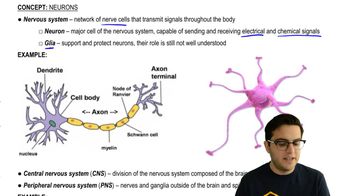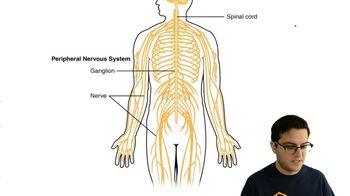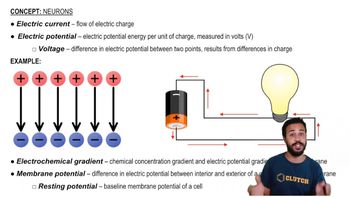Table of contents
- 1. Introduction to Biology2h 42m
- 2. Chemistry3h 40m
- 3. Water1h 26m
- 4. Biomolecules2h 23m
- 5. Cell Components2h 26m
- 6. The Membrane2h 31m
- 7. Energy and Metabolism2h 0m
- 8. Respiration2h 40m
- 9. Photosynthesis2h 49m
- 10. Cell Signaling59m
- 11. Cell Division2h 47m
- 12. Meiosis2h 0m
- 13. Mendelian Genetics4h 44m
- Introduction to Mendel's Experiments7m
- Genotype vs. Phenotype17m
- Punnett Squares13m
- Mendel's Experiments26m
- Mendel's Laws18m
- Monohybrid Crosses19m
- Test Crosses14m
- Dihybrid Crosses20m
- Punnett Square Probability26m
- Incomplete Dominance vs. Codominance20m
- Epistasis7m
- Non-Mendelian Genetics12m
- Pedigrees6m
- Autosomal Inheritance21m
- Sex-Linked Inheritance43m
- X-Inactivation9m
- 14. DNA Synthesis2h 27m
- 15. Gene Expression3h 20m
- 16. Regulation of Expression3h 31m
- Introduction to Regulation of Gene Expression13m
- Prokaryotic Gene Regulation via Operons27m
- The Lac Operon21m
- Glucose's Impact on Lac Operon25m
- The Trp Operon20m
- Review of the Lac Operon & Trp Operon11m
- Introduction to Eukaryotic Gene Regulation9m
- Eukaryotic Chromatin Modifications16m
- Eukaryotic Transcriptional Control22m
- Eukaryotic Post-Transcriptional Regulation28m
- Eukaryotic Post-Translational Regulation13m
- 17. Viruses37m
- 18. Biotechnology2h 58m
- 19. Genomics17m
- 20. Development1h 5m
- 21. Evolution3h 1m
- 22. Evolution of Populations3h 52m
- 23. Speciation1h 37m
- 24. History of Life on Earth2h 6m
- 25. Phylogeny2h 31m
- 26. Prokaryotes4h 59m
- 27. Protists1h 12m
- 28. Plants1h 22m
- 29. Fungi36m
- 30. Overview of Animals34m
- 31. Invertebrates1h 2m
- 32. Vertebrates50m
- 33. Plant Anatomy1h 3m
- 34. Vascular Plant Transport1h 2m
- 35. Soil37m
- 36. Plant Reproduction47m
- 37. Plant Sensation and Response1h 9m
- 38. Animal Form and Function1h 19m
- 39. Digestive System1h 10m
- 40. Circulatory System1h 57m
- 41. Immune System1h 12m
- 42. Osmoregulation and Excretion50m
- 43. Endocrine System1h 4m
- 44. Animal Reproduction1h 2m
- 45. Nervous System1h 55m
- 46. Sensory Systems46m
- 47. Muscle Systems23m
- 48. Ecology3h 11m
- Introduction to Ecology20m
- Biogeography14m
- Earth's Climate Patterns50m
- Introduction to Terrestrial Biomes10m
- Terrestrial Biomes: Near Equator13m
- Terrestrial Biomes: Temperate Regions10m
- Terrestrial Biomes: Northern Regions15m
- Introduction to Aquatic Biomes27m
- Freshwater Aquatic Biomes14m
- Marine Aquatic Biomes13m
- 49. Animal Behavior28m
- 50. Population Ecology3h 41m
- Introduction to Population Ecology28m
- Population Sampling Methods23m
- Life History12m
- Population Demography17m
- Factors Limiting Population Growth14m
- Introduction to Population Growth Models22m
- Linear Population Growth6m
- Exponential Population Growth29m
- Logistic Population Growth32m
- r/K Selection10m
- The Human Population22m
- 51. Community Ecology2h 46m
- Introduction to Community Ecology2m
- Introduction to Community Interactions9m
- Community Interactions: Competition (-/-)38m
- Community Interactions: Exploitation (+/-)23m
- Community Interactions: Mutualism (+/+) & Commensalism (+/0)9m
- Community Structure35m
- Community Dynamics26m
- Geographic Impact on Communities21m
- 52. Ecosystems2h 36m
- 53. Conservation Biology24m
45. Nervous System
Neurons and Action Potentials
Problem 12b`
Textbook Question
Certain species of frogs in the genus Phyllobates have a powerful defensive adaptation—their skin can secrete a milky fluid that contains an extremely toxic compound called batrachotoxin (BTX). These frogs, which are found in Colombia, are known as poison dart frogs because some indigenous Colombian hunters coat the tips of their blowgun darts with the frogs' skin secretions. An animal hit by one of these darts dies quickly.
What is the mechanism of action of BTX?
Identify a research technique that could be used to discover how BTX affects specific membrane proteins.
Based on the graph in Question 11, what would you expect this technique to show?
 Verified step by step guidance
Verified step by step guidance1
Batrachotoxin (BTX) is a potent toxin that affects the nervous system by targeting voltage-gated sodium channels in nerve cells. It binds to these channels and keeps them open, preventing the normal closing mechanism. This leads to a continuous influx of sodium ions, causing prolonged depolarization of the nerve cell membrane, which disrupts normal nerve signal transmission.
To study how BTX affects specific membrane proteins, researchers could use a technique called patch-clamp electrophysiology. This method allows scientists to measure the ionic currents through individual ion channels in the cell membrane, providing detailed information about how BTX alters channel function.
In a patch-clamp experiment, researchers would isolate a small patch of the cell membrane containing sodium channels and apply BTX to observe changes in the electrical activity. They would measure the current flow through the channels before and after BTX application to determine its effect on channel opening and closing.
Based on the graph in Question 11, which likely shows the effect of BTX on sodium channel activity, you would expect the patch-clamp technique to show a sustained increase in sodium ion current through the channels. This would indicate that BTX keeps the channels open, preventing them from closing properly.
The results from the patch-clamp technique would provide insights into the specific changes in channel kinetics caused by BTX, helping to understand its mechanism of action at the molecular level.
 Verified video answer for a similar problem:
Verified video answer for a similar problem:This video solution was recommended by our tutors as helpful for the problem above
Video duration:
1mPlay a video:
Was this helpful?
Key Concepts
Here are the essential concepts you must grasp in order to answer the question correctly.
Batrachotoxin (BTX) Mechanism of Action
Batrachotoxin (BTX) is a potent toxin that affects the nervous system by binding to voltage-gated sodium channels in nerve and muscle cells. This binding forces the channels to remain open, leading to continuous sodium influx, which disrupts normal electrical signaling and results in paralysis or death. Understanding BTX's mechanism is crucial for comprehending its lethal effects on animals.
Recommended video:
Guided course
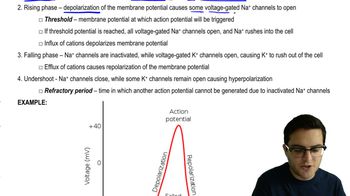
Action Potential
Voltage-Gated Sodium Channels
Voltage-gated sodium channels are essential membrane proteins that facilitate the rapid influx of sodium ions during the depolarization phase of action potentials in neurons and muscle cells. These channels are critical for the propagation of electrical signals in the nervous system. BTX alters their function, causing prolonged activation and disrupting normal cellular communication.
Recommended video:
Guided course
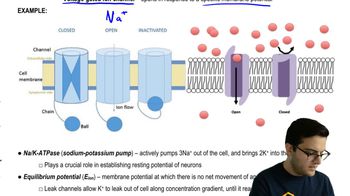
Ion Channels and Pumps
Patch-Clamp Technique
The patch-clamp technique is a powerful research method used to study ion channels in cells. It allows scientists to measure the ionic currents through individual channels, providing insights into their function and regulation. By applying this technique, researchers can observe how BTX affects sodium channel activity, helping to elucidate its impact on cellular electrophysiology as suggested by the graph in Question 11.
Recommended video:
Guided course

X-Inactivation
Related Videos
Related Practice



